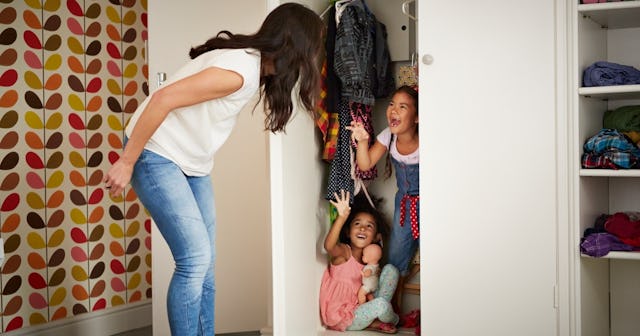How To Play Sardines — Because You Absolutely Must Play Sardines

Growing up in the church and going to youth group from middle school through high school, I cannot tell you how many times I’ve played Sardines. It’s the absolute perfect game for a group of kids and teenagers. Shoot, I’ve even convinced a small group of adults to play it once. What could possibly be better than being cramped into a tight space with a few of your closest friends while desperately trying to remain unseen and unheard?
Playing Sardines seems to have the same effect as when our parents or grandparents would see how many friends they could fit in a phone booth or a VW Bug. It’s super silly and tons of fun! It’s a game I continue to recommend for sleepovers, outside at camp outs and any other time when a gaggle of people end up together and looking for something to do. How do you play? Glad you asked! It’s actually really simple.
What is Sardines?
The best way to think of the Sardines game is as a “reverse Hide and Seek.” Instead of everyone hiding all at once and one person doing all the seeking, the game starts with one person hiding and everyone else counting to a predetermined number. Once the number is reached, the rest of the group begins hunting down the original hider. Here’s where it gets the most interesting, though. As friends/seekers find the original hider, they must hide with them. Picking the right hiding place is essential. Picking the wrong hiding place just makes things more fun.
Where can you play Sardines? Who can play?
There’s really no minimum age requirement, but younger kids often have a hard time grasping the concept, remaining quiet or feeling comfortable being alone in anticipation. For that reason, we’d suggest going with ages 12 and older. The optimal group size is 4 to 8, but we’ve played with as many as 12 before. As for where you can play, the options are almost as endless. While playing with my youth group, we used the entire church (sanctuary, kitchen, community room and all of the Sunday School rooms). When I played with neighbors, we either limited to only outside or only inside, but opened it up to 2 to 3 houses, depending on whose mamas allowed it. While the associates weren’t very happy about a bunch of 18 year olds scurrying around their store, we even managed to play a few rounds at the IKEA near my college. There really are no limits, as long as everyone can remain safe and you can avoid being too much of a nuisance.
Sardines is a super fun kid’s birthday party game as it gets every child involved and interacting with each other. Plus it gives the parents a few moments of peace and quiet to chat while the kid’s are keeping extra quiet behind the couch.
Optimal Sardines Hiding Places
You didn’t think I’d leave you without a bit of help, did you? Here are the best places you can hide.
Closets (Any kind)
Pantries Behind Couches Trees (This really only works if everyone in the group can easily climb trees. Only if it’s safe!) Sheds Green Houses Under kitchen islands On the top bunk Cars (Safety first! Only use this option if it’s cool enough and safely parked in a driveway.) Forts Bushes Bathrooms (or one bathroom stall) Bathtubs Showers Laundry rooms Under a large desk Under a pool table (They typically have walls that hang down, plus they’re usually in basements, where it’s always dark.)
A note about safety: if there are younger kids playing the game, make sure you’re aware of where the kids have chosen to hide, that it is safe, and that you keep an eye on them (without giving away the spot to the searchers, obviously). You can also designate certain areas of the house as up for grabs. For example, only the main floors, no attic, no basement, no garage.
Still need a visual aid on how the game works? This fun video of a Sardines game between two families is a great example of how much fun this game is. Dare we say it’s more fun than regular hide and seek?
This article was originally published on